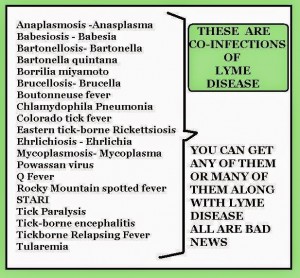Written by Paula Jackson Jones and Angele Rice, co-founders of Midcoast Lyme Disease Support & Education (MLDSE), a nonprofit organization.
 May is recognized statewide, by proclamation of the Governor, as Lyme Disease Awareness Month, because of the increased risk when immature ticks emerge in the springtime. While many people know something about Lyme, there are many common misconceptions. Did you know that ticks can carry more than one infectious bacterium at a time? Did you know that there are over 100 strains of tick-borne bacteria in the US and most tests are only testing for 1 strain? It is our goal to raise awareness about the fastest growing vector-borne infectious disease, not only in Maine but throughout the United States.
May is recognized statewide, by proclamation of the Governor, as Lyme Disease Awareness Month, because of the increased risk when immature ticks emerge in the springtime. While many people know something about Lyme, there are many common misconceptions. Did you know that ticks can carry more than one infectious bacterium at a time? Did you know that there are over 100 strains of tick-borne bacteria in the US and most tests are only testing for 1 strain? It is our goal to raise awareness about the fastest growing vector-borne infectious disease, not only in Maine but throughout the United States.
Why are we choosing to be so vocal here within our community? Because Midcoast Maine has the highest level of Lyme Disease in the entire state and that’s data based solely on the cases that the Maine Center for Disease Control (CDC) knows about. In 2013, the top three counties infected with highest count of Lyme Disease cases were Knox, Lincoln and Sagadahoc respectfully (the 2014 data will not be released until August 2015). There are countless more who have been forced to seek diagnosis and treatment outside of Maine and those numbers are not supported by our local data. It’s time to raise awareness, it’s time to educate, it’s time to advocate and it’s time to step up and support those in need. And that starts with PREVENTION!
Maine is a state with lots of outdoor activities. Through preventative education, we can continue to safely enjoy those outdoor activities without fear of contracting Lyme. Should we come into contact with a tick, we are armed with awareness for treatment options to combat the potential for tick-born infection to disseminate. Ticks are everywhere and are waiting for a host to come along to feed upon. They transport on our pets, on our outerwear, even through contact with tree and shrub branches. They crawl into places where we can not see them until its too late. With the right amount of prevention, it makes it difficult for ticks to survive and therefore, unable to attach and transmit infections. There are lots of options available to suit your lifestyle. Some opt for harsh chemicals while others prefer a more natural approach. Harsh chemicals can be toxic to pets and children. Prevention is about layered security.
Treat your clothing: Permethrin is a great recommendation for all your outer wear. Spray liberally and allow to fully dry. DO NOT PUT IT ON YOUR SKIN. It will last through 5-10 washes. If you work outdoors, you can send your clothing away to be treated with a more concentrated level of Permethrin which lasts for up to 75 washes.
Treat your skin: Products that contain Deet are the most effective. The higher the % of Deet the more effective. But for those who are sensitive to chemicals and especially for children, there are other options. There are kid-friendly bug sprays that work for mosquitoes but are not as effective for repelling ticks. I share an Essential Oil recipe on our website: Using a carrier oil like coconut or jojoba oil, fill half a spray bottle with your carrier oil, then add equal 1/3 parts of Lemongrass oil, Eucalyptus oil and Rosemary oil. Shake up and spray. It lasts about 4-6 hours and is safe for adults, children and pets (not to mention the individual healing benefits that each oil has). DO NOT USE TEA TEA OIL or ROSE GERANIUM OIL = VERY TOXIC TO PETS.
Treat your pets: There are lots of options for your pet from vaccines to collars to drops to sprays. Your Vet can offer you comfortable suggestions for your pets that are safe and effective.
Treat your yards: Ticks LOVE to hang out in wet areas so, on those warm and sunny days, get out there cut back the underbrush on the outer areas of your yard. Keep your lawn mowed as that keeps the moisture levels down and prevents ticks from hanging out. There are chemical sprays and granules that you can buy at local hardware stores, as well as businesses who offer to come and spray treat your yard. Again, you have options.
So PREVENTION starts with YOU! Treat your clothing, treat your skin, treat your pets and treat your yards. A little prevention goes a long way towards your defense against Lyme and other tick-borne diseases that are so very prevalent right here in our community.


